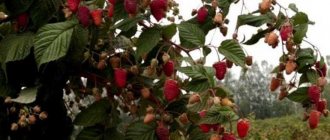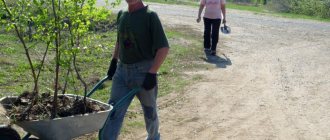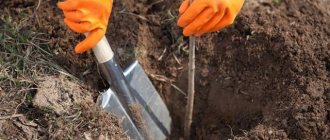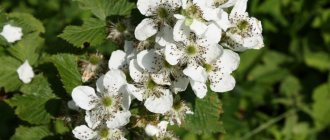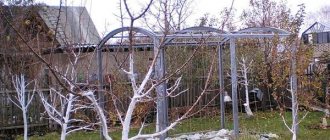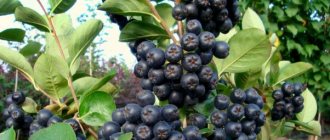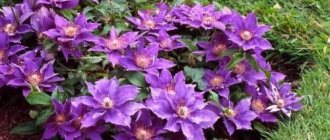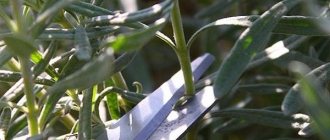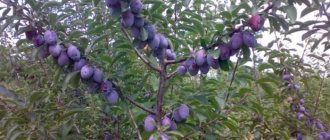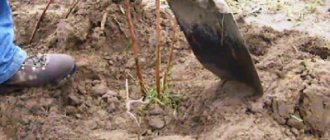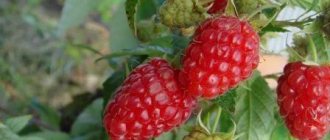Features of remontant strawberries
Remontant strawberries differ from ordinary strawberries in the time of fruit bud formation. In ordinary strawberries, fruit buds are formed during short daylight hours, and in remontant strawberries, during neutral or long ones. Therefore, remontant varieties, when grown in open ground, bear fruit twice a season: the first time in July, and the second time at the end of August/beginning of September.
The second harvest may be much larger than the first. It can even account for up to 90% of the total number of berries per bush per season, although most often this figure approaches the 60% mark.
Remontant varieties are large-fruited. The weight of 1 berry in some cases can even reach 100 grams. On average, the weight of 1 berry varies from 20 to 75 grams, depending on the variety.
In the absence of special care, already in the second year of growth of the bush, the berries are small and sparse, and in the third year the plant most often dies.
Let's sum it up
Skincare procedures carried out in the fall are determined by many factors, for example:
- will the strawberry bushes survive the winter;
- will they produce a harvest?
- will the berry be large?
- how abundant the fruit harvest will be, etc.
Don’t be lazy and purchase enough manure and mineral fertilizers. Even if you move your strawberry beds year after year, fertilizing the soil will have a beneficial effect on other crops.
As for collecting mulch, it can be done right on your site, or you can purchase straw from the farmers who collect it. The price of such autumn preparation is not high, but you will have to work hard. However, all your efforts will pay off when you harvest.
Video – Remontant strawberries
Such a garden plant as the remontant strawberry began to be found in the garden beds of non-professional gardeners quite recently. Due to its recent introduction into widespread use, not all gardeners know how to properly care for an unusual varietal berry, and out of habit they carry out the same manipulations with the plant as for ordinary strawberries. However, in this way, gardeners do not allow the plant to reveal its potential, and as a result, they do not receive enough potential harvest. In this material we will tell you what kind of treatment remontant strawberries require, care in the fall, as well as manipulations performed at other times of the year, we will discuss in detail separately.
Soil preparation
It is better to grow these varieties of strawberries in the area where crops such as carrots, parsley, garlic, radishes, beets or legumes previously grew. At the same time, it is not recommended to plant this crop after potatoes or cucumbers (as well as after tomatoes and cabbage). In addition, it is better not to grow this plant next to raspberries.
The area chosen for planting should be in direct sunlight. In addition, the soil on the site should be level and free of bumps and depressions. Location in lowlands is not allowed.
It is best if the garden bed has sandy or loamy soil. Peat soil, like sod-podzolic soil, is not suitable for growing this crop.
The soil for planting should be either slightly acidic or neutral. It is necessary to prepare the soil for planting in advance. If the crop is planned to be planted in the spring, then preparation is carried out in the fall; if planting will be done in the fall, then the soil is prepared in the spring or summer.
At the beginning of preparation, it is necessary to dig up the ground with a pitchfork and level it with a rake. During digging, it is necessary to remove weed roots and also add fertilizer. As such fertilizers, you can use humus or compost in the amount of 1 bucket per square meter of land. It is also necessary to add 5 kg of wood ash to the soil (the figure is based on 10 square meters).
Once the soil has been fertilized, dug up and leveled, it can be left until planting. A month before the intended planting of the bushes, it is necessary to add potassium sulfate (in the amount of 20 g) to the soil with the addition of superphosphate, which must be taken twice as much as potassium sulfate (the numbers are based on each square meter). After applying the fertilizer, the soil is dug up again.
How to prepare strawberries for planting
Remontant strawberries love fertile soil, they just need good drainage. If possible, strawberries are planted on loamy soil. Sand is added to heavy soil before planting.
Planting remontant strawberries is effective after parsley, radishes or beans. The land after these crops is disinfected and enriched with nutrients. The site must be prepared in the fall to make it more convenient to plant bushes in the spring. The soil is dug up and all weeds are removed. Humus and fertilizers with phosphorus are added to the soil. The prepared soil is left to overwinter. In the spring, about three weeks before planting, rotted manure is added to the soil. And at the end of spring you can start planting strawberry crops.
Some gardeners believe that planting remontant strawberries in the fall is also possible, but in this case the work should be done in early September, while there is no frost on the soil.
Planting seedlings
With different planting methods, care also differs. The planting time for each type of strawberry may also differ.
Dates and methods of planting
Planting in the ground is carried out in the autumn or in the spring. For the southern regions, it is preferable to plant seedlings in the ground in early September, while for the northern regions it is preferable to plant seedlings in the spring months, but not earlier than May.
For central Russia, it is preferable to choose the autumn months, from the beginning of August to the end of September, but it is also possible in the beginning of spring - from the end of March to mid-April.
You should focus on the temperature regime: the optimal air temperature when planting seedlings is 15-25 degrees Celsius.
Methods of planting seedlings in the ground
- carpet;
- nesting;
- private.
With the nesting method, the distance between plants is set at least half a meter. This method of planting seedlings is suitable for varieties that throw out tendrils. This planting method allows you to get not only a good harvest, but also high-quality planting material.
The advantage of this planting method is that the plants do not come into contact with each other, which means they do not infect each other when diseases occur. In addition, the bushes are well lit, as they do not shade each other.
Among the disadvantages are unused areas of land, of which there are quite a lot with this planting method, since the distance between the bushes is approximately 50 cm.
The distance between strawberry bushes is set at 20 cm - this is with the carpet method. Moreover, 20 cm is not only the distance between the bushes of the 1st row, but also the distance between the rows.
With the row method of planting this crop, a larger distance between the rows is provided - up to 70 cm, while the distance between the bushes remains the same - from 20 to 25 cm. The bushes will grow over time, at the same time the area of the plantation will increase.
Landing dates
For regions with different climates, planting periods differ significantly:
- Early: begins at the end of August and continues until the beginning of September;
- Average: from late September to mid-October;
- Late: begins at the end of October and lasts until the beginning of November.
note
Even late planting is suitable for warm regions; for the middle zone and northern regions only early or medium planting is suitable.
Most gardeners say that strawberries planted in the early or mid-season bring the greatest amount of harvest next year. Since strawberries planted later are partially damaged by frost and bear fruit much worse.
The best time for planting is considered to be from mid-August to the end of September. Plants planted during this period have time to become sufficiently strong and prepare for frost.
Methods of growing in open ground
There are many ways to grow this crop. For small summer cottages, non-standard planting methods have been specially developed, which greatly save space on the site.
On the ground in the beds
Among the classic ones, two methods of planting can be distinguished:
- one-liner:
- two-line.
With the one-line method, the distance between the rows is maintained at least 60 cm, and with the two-line method - no more than 30. The one-line planting method is safer for plants, since they do not come into contact with each other and, accordingly, cannot infect each other.
The two-line planting method increases yields because the soil is used more efficiently.
For small areas, there are other ways to plant remontant strawberries in open ground, for example, the vertical method or “in bags.”
Vertical method
With the vertical method, strawberries are planted in pots, cut pipes, tires, boxes or any other containers that can be placed vertically. At the same time, space is greatly saved, since pots with bushes can be placed vertically on several floors. But in this case, care becomes a little more complicated.
"In bags"
When planting in bags, plastic bags are used in which soil is placed, and seedlings are planted in it. Such bags are hung vertically, which also saves space. Holes are made for plants.
Under covering material
Planting a bush of this crop under covering material makes caring for the plant much easier. Growing strawberries in this way allows you to create a microclimate in which the soil does not dry out, but at the same time, due to the lack of sunlight, weeds do not grow under the agrofibre.
In addition, due to the constant humidity under the covering material, earthworms begin to actively live and loosen the soil, so caring for strawberries planted in this way is much simpler.
The berries do not come into direct contact with the soil and this has a beneficial effect on the quality of the product. Therefore, growing remontant strawberries under covering material is a fairly progressive way to get high yields at fairly low costs.
How to plant berries
You can plant remontant strawberries using one of the following methods:
- Nest method. This is the most convenient and popular way of planting remontant varieties of strawberries, if a variety that reproduces by tendrils is selected.
- Carpet. Strawberry bushes are planted in the soil 20 cm apart. The result is a kind of planting squares, which will be filled over the years, since the strawberries grow quickly and strongly.
- Ordinary method. The bushes are planted in rows, 20 cm are left between the bushes, but 70 cm between the rows. For planting, holes are made about 14 cm deep.
The root collar should remain level with the ground or slightly higher. Near the roots you can sprinkle fertilizer to promote rapid rooting, then sprinkle with soil.
Caring for remontant strawberries during the active growing season
The number of bushes, the quality of the root system and, as a result, the number and size of berries collected from one bush per season depend on the quality and correct care of the plant.
Watering and fertilizing
During the growing season, sufficient attention should be paid to soil moisture. If there is a lack of moisture in the soil, insufficient formation of the ovary or the formation of fruits of irregular shape may occur. All this has a detrimental effect on the quantity and quality of the harvest. Therefore, watering should be regular.
Mulching open areas of land around bushes will help reduce the costs associated with regular soil irrigation. This will lead to moisture retention in the soil, which in turn will allow the plantation to be watered less frequently.
In spring it is necessary to fertilize the soil. For this purpose, ammonium nitrate and potassium sulfate are used. Their quantity is calculated based on the formula: 15 g of substance per 1 square meter of soil.
This calculation is correct for both types of fertilizers. Superphosphate is also used for feeding. Per square meter it is needed twice as much as potassium sulfate.
Pruning remontant strawberries
During the growing season it is necessary to trim the mustache. This should be done throughout the spring and summer period. If you plan to grow new shoots, then the mustaches are not cut, but dug in, and thus by August there will already be young bushes that are ready for replanting. In autumn, pruning of leaves and tendrils is carried out.
All red, blackened, dried or infected shoots are removed. In this way, the bush prepares for wintering in order to more easily endure the winter cold.
What and how affects the quality of the crop
The quality and quantity of the harvest is affected by proper care of bushes and young shoots. The amount of harvest is greatly influenced by the regularity of watering and the absence of pests and diseases in the plant. In addition, the benefits of regular feeding should not be underestimated. During the growing season, fertilizing can be done twice a month.
Also, the correct trimming of the mustache has a great influence on the quality of the harvest. Because young shoots require a lot of effort to take root.
In the absence of proper care for the bushes, the strawberries will be few and small.
Care
To better understand how to properly care for remontant strawberries, it is necessary to take into account the peculiarities of their development. Unlike single-fruiting varieties, remontant varieties experience greater stress. Therefore, they definitely require appropriate feeding and timely watering.
Watering
Strawberry is a moisture-loving plant. It should be watered regularly throughout the growing season. This is explained by the superficial root system of the plant, which is damaged when the surface layer of soil dries out. The frequency of watering strawberries depends on weather conditions:
- in spring and early summer, before the onset of stable heat, the plants are watered weekly;
- When the temperature rises significantly, watering is carried out 2-3 times a week; it is necessary to monitor the humidity level.
Attention! Flood is no less harmful to strawberries than drought. Excess moisture very often causes the development of various rots.
With sufficient watering, strawberry rosettes quickly grow leaf mass and lay a large number of flower buds. With a lack of moisture, metabolic processes are inhibited, and the plants themselves look depressed.
Watering is best done in the morning or evening. It is advisable that the irrigation water be warm. Strawberry bushes are watered strictly at the root. To reduce labor costs, you can install drip irrigation on strawberry beds.
Top dressing
When caring for strawberries, timely application of fertilizers is mandatory. The best option is to alternate organic matter with mineral fertilizers.
The timing of fertilizer application for remontant varieties is as follows:
- Immediately after the snow melts, the bushes are fed with a urea solution.
- After 2 weeks, phosphorus-potassium fertilizers are used. They promote the formation of flower buds.
- After harvesting, remontant strawberries are fed with a fermented mullein solution.
- In early August, phosphorus-potassium fertilizers are reused.
Attention! Fertilizers should not be applied in the fall. Strawberries that have begun to grow overwinter very poorly.
Mustache trimming
After planting, caring for strawberries also involves trimming the mustache. The peak of their growth occurs in the second half of summer. The mustache develops from dormant buds located at the bottom of the bush. As they grow, the rows thicken and the yield decreases significantly.
Mustaches should be trimmed as they grow. Usually they are removed 2-3 times during the summer. For pruning, use pruning shears or sharp scissors. Upon completion of work, all plant residues must be removed.
Spring-summer mustaches are often used to propagate the best remontant varieties. They perfectly convey varietal characteristics. With their help, you can quickly obtain a fairly large amount of high-quality planting material.
Features of autumn care
When growing remontant varieties with long daylight hours, the crop sometimes does not have time to ripen completely. With the onset of early frosts, the bushes do not have time to adapt to them and die. Therefore, in the fall, when caring for remontant strawberries, it is necessary to create protective shelters. For example, bushes can be covered with pine spruce branches, a layer of straw or a special perforated film. They will protect the bushes from freezing.
When caring for strawberries, you should pay attention to the prevention of diseases and pests. To do this, before the onset of stable frosts, all leaves are cut off from the bushes. After which I treat the strawberry bed with a fungicide solution. For example, you can use Bordeaux mixture. After completion of work, all plant residues must be destroyed. If this is not done, they can become a breeding ground for pests and diseases.
Propagation of remontant strawberries
Propagation of remontant strawberry varieties is carried out in at least three ways:
- growing from seeds;
- by dividing the bush;
- and with the help of a mustache.
Growing seedlings from seeds
When growing strawberries from seeds, the purest varieties are obtained. This planting method is very labor-intensive, since it is carried out in the spring and lasts for several months.
Seeds must be prepared in advance. Preparations must begin as early as February, and only in mid-May will the seedlings be ready and need to be planted in the beds.
Dividing the bush
The method of propagating remontant strawberries by dividing the bush is resorted to in case of an insufficient number of seedlings or when it is necessary to quickly move part of the plantation to another place. To grow strawberries using this method, you need strong and healthy plants. Therefore, they choose either two-year-old or four-year-old bushes. Their root system should be strong and healthy.
At 4 years of age, the bush has several dozen shoots of horns. Each horn is already well developed, has lateral buds and formed leaves. In addition, it has well-developed adventitious roots. Such plants can be planted only in spring, or in emergency cases - in early autumn. Having dug such bushes from the ground, they must be divided and planted immediately.
After transplanting, it is necessary to water the plants daily. If it is scorching hot outside at this time, it is necessary to provide the young seedlings with constant shade.
Reproduction by mustache
Propagation by mustache is an economical method that is the easiest in terms of labor costs. In addition, new bushes obtained in this way give a harvest next year.
However, when propagating strawberries using this method, it is necessary to sacrifice the second harvest of the season. The fact is that the strawberry bush spends energy either on the formation of berries, or on the development and rooting of the mustache. Therefore, if you want to obtain high-quality planting material, you must refuse to obtain a second harvest.
For propagation in this way, annual bushes are selected that, at the first fruiting, produced large, even berries. The first tendrils that appear must be spread around the bush, giving them the opportunity to take root. Whiskers that appear later must simply be removed.
By August the young bushes will be ready. A week before moving them to a new place, it is necessary to trim the mustache that connects them to the mother bush. Young bushes are transplanted to a new location using a small spatula.
It is advisable to move the bushes with a small lump of earth, this way the root system will suffer less and the plant will more easily tolerate replanting.
Diseases of remontant strawberries
Gray rot
Remontant garden strawberries are often attacked by gray rot. It manifests itself most actively in dense plantations, where the soil is not loosened and frequent watering is carried out, especially with sprinkling and cold water. Gray rot can affect all above-ground organs of the plant, which will lead to losses of up to 85% of the entire crop. In order to prevent the appearance of gray rot on remontant strawberries, it is necessary to plant on the site in accordance with the characteristics of the growth and development of a particular variety, to mulch the soil, as well as sufficient, but not excessive watering. At the first sign of infection, the affected parts of the plants should be removed.
As a preventive measure, you can treat plants at the very beginning of the growing season with 2.0% Bordeaux mixture, and after harvesting at the very end of the growing season, to consolidate the result, with a 1% solution of colloidal sulfur.
There are also fungicides to combat the disease, but you can only use approved ones, in full accordance with the instructions on the package, for example, Strobi, Switch, Euparen, Triadimefon (Bayleton), Captan. The biological product Alirin-B is considered the safest from the list of recommended ones.
Brown spot
It manifests itself when, as in the previous case, strawberry plantings are thickened, there is too much moisture, and day and night temperatures fluctuate noticeably. As a preventive measure in the spring, remove all dry leaves so that the infection does not “settle” on them and treat with 2% Bordeaux mixture. Do not forget about mulching, which will not allow the fungus to reach the surface.
If the disease is very active, then use approved fungicides, strictly following the instructions on the package, for example, Skor, Strobi, Fundazol.
Powdery mildew
The first sign of the appearance of this disease is the purple color of the strawberry leaf blades, then they curl and become ash-gray, as if sprinkled with old flour. If you don’t want this disease to come visit you, then in early spring, treat the plants with a weak (slightly pink) solution of potassium permanganate or 1% colloidal sulfur.
There are also fungicides, but use only approved ones and exactly in accordance with the instructions on the package, for example, Topaz, Fundazol, Tilt, Strobi and Fitosporin-M.
Brown spotting on strawberry leaves. © Tip10
Powdery mildew on strawberry leaves. © gov.au
Autumn preparation for winter
Autumn preparation involves removing everything that could prevent the bush from overwintering normally and bearing fruit with renewed vigor starting in the new season. This means removing any runners that have not taken root, as well as any damaged, reddened or weak leaves.
In addition, in harsh winters, any strawberries must be covered. It is better to choose a material whose density is about 60 grams per square meter. Agrofibre, spunbond or any other material is suitable for these purposes.
Mulch, pine needles, leaves or grass are also used to cover strawberries. Although this method appears to be more economical than purchasing fiber, there are a number of disadvantages to using it. In this case, mice may appear in the shelter, which are enemies of strawberries. They damage shoots and dig tunnels.
When covering a strawberry plantation, it is better to opt for special covering materials or thick plastic film.
Pruning strawberries in autumn
There is no consensus on whether strawberries should be pruned for the winter. Some fear that this will greatly weaken the plants, others believe that pruning makes it possible to destroy pests and fungal spores that remain on the leaves for the winter.
If you decide to trim all the leaves, do it at the end of October. The plants are already in an inhibited state; they will not grow new leaves, and therefore will not expend energy on growing green mass. Be careful with the heart - do not cut off the central bud along with the foliage.
If you decide not to prune, remove all lower, damaged and defective leaves. Any spots can be the source of a dangerous disease. Ruthlessly cut off everything except the smooth green leaves, leaving stubs of 2-3 cm. Cut out the flower stalks completely - in the fall they only weaken the plants. Do not leave cut greens in the garden beds. It can be placed in a compost heap or burned.
Varieties of remontant strawberries
There are several dozen varieties of remontant strawberries. Only a few of them will be described below.
Autumn fun
This variety was popular back in Soviet times; it was one of the first to be included in the Soviet DSD selection. The bush of this variety bears fruit twice a season, with proper care. The berries are small in size, their weight most often does not exceed 20 g. The taste of the berries is quite sweet; the fruits of this variety of strawberries are used to create all kinds of desserts. The pulp of this species is quite dense, so they are often used for freezing.
This variety is propagated with the help of mustaches, of which the bush produces a lot during the season. The variety is also resistant to attacks by fungal infections and strawberry mites.
Russian size
This variety is distinguished by large fruits. Moreover, it is frost-resistant and therefore suitable for cultivation in more northern regions. The berries are very juicy, the plants are resistant to diseases.
Galya Chiv
A fairly new hybrid variety, bred in Italy, which is characterized by high productivity. The average weight of one berry is about 45 g. The color of the berries is bright red, in addition, they are distinguished by their high sugar content.
Vima Rina
This is a Dutch variety; it lays fruit buds during neutral daylight hours. Vima Rina practically does not produce antennae, so it is propagated in other ways. This variety bears fruit starting from the second half of June and continues until the first frost.
The color of Vima Rin's berries is deep red, darker than those of other varieties. The fruits are large, weighing up to 75 g. The taste of this strawberry is sweet and soft, and the density of the berries is low (they are not suitable for freezing).
Diamond
Diamond is an American variety. At the moment it is considered the best among all varieties of remontant strawberries.
This species is propagated using a mustache.
Selva
This variety is one of the best. Firstly, it is very highly productive, and secondly, it has excellent taste. Large fruits, reaching 50 g, are dark red in color, and have light flesh inside.
Queen Elizabeth 2
For Queen Elizabeth II, the weight of 1 berry can reach record figures of up to 110 grams. This is a very frost-resistant variety and produces its first fruits quite early.
Novel
This hybrid variety has pink flowers. This feature makes it easy to distinguish Roman from other types of remontant strawberries.
This variety can be grown in protected soil. With proper care, it can bear fruit for up to 10 months a year. The berries are not large - up to 25 grams.
Lyubasha
Lyubasha is unpretentious, frost-resistant, has small, dark red fruits. Most often it is used for vertical cultivation, since the berries are formed not only on bushes, but also on rosettes.
Let's sum it up
Skincare procedures carried out in the fall are determined by many factors, for example:
- will the strawberry bushes survive the winter;
- will they produce a harvest?
- will the berry be large?
- how abundant the fruit harvest will be, etc.
Don’t be lazy and purchase enough manure and mineral fertilizers. Even if you move your strawberry beds year after year, fertilizing the soil will have a beneficial effect on other crops.
As for collecting mulch, it can be done right on your site, or you can purchase straw from the farmers who collect it. The price of such autumn preparation is not high, but you will have to work hard. However, all your efforts will pay off when you harvest.
Video – Remontant strawberries
| Rapid onset of old age and weakening of plants | Strawberries of day-neutral varieties, due to heavy loads, quickly age and, consequently, become smaller. It turns out that in the first year you will collect large fruits, in the second only small ones. To avoid disappointment, you must:
|
| Removing bushes at the end of the season | Day-neutral varieties are recommended to be removed from the beds after the fruiting season to allow the soil to rest and gain nutrients. |
| Mulching beds | Remontant strawberries are required in the process of growing mulching beds, using:
|
| Covering beds | Strawberries of the variety in question involve the use of organic growing methods. Leaving them naked is prohibited. If you do not mulch the soil, cover it in other ways. |
How to feed strawberries after harvest
You can feed strawberries both in spring and autumn, but it is always better to feed berry bushes immediately after fruiting or, if you don’t have time, then in the fall. Fertilizing strawberries after fruiting is possible with organic fertilizers - infusion of chicken manure or mullein. I wrote how to do this in the article on how to feed strawberries in the fall.
Wood ash is also added, which perfectly replaces superphosphate and potassium salt (I am not a supporter of mineral fertilizers). Of the mineral fertilizers in the fall, the already mentioned superphosphate (gardeners' reviews of Superphosphate) and potassium salt are applied. Do this only if you currently have nothing available from organic fertilizers.
Cleanliness and order in the garden
First of all, it is important to remove old leaves. Of course, their first pruning should be done after harvesting. As you know, the lifespan of a strawberry leaf is about 3 months, so by the time the berries ripen, a significant part of the green mass of the bush has already aged. But in the fall you need to pay attention to pruning.
So, we remove the old foliage, as well as the newly formed mustache. You can leave only 3-4 fresh leaves, but you should not remove all the green mass. It is extremely undesirable to tear it with your hands, since this damages the bush as a whole, even if this is not noticeable. It is good to use pruning shears or garden shears. At the same time we carry out weeding.
Old leaves and tendrils need to be removed. Photo by the author
We remove the cut leaves and tendrils from the garden bed and burn them. In this way we get rid of a large number of pests that are settling in or have already settled down for the winter.
At the same time we are inspecting the bushes. If something went wrong with some of the specimens, they look bad or are completely gone, then now is the time to replace them. To do this, we remove the old roots and plant well-rooted seedlings prepared in advance.
This plant needs to be replaced. Photo by the author
You can grow young plants yourself from seeds, tendrils, or by dividing an adult bush. You can read how to get your own seedlings using whiskers or dividing a bush in the publication Whiskers and horns - ways to propagate garden strawberries. And the next video demonstrates the entire process of creating a new bed of garden strawberries, starting from preparing the soil, growing your own seedlings and ending with planting them in a permanent place.
